
Content
Welcome to the Club of Amsterdam Journal.
Des Leach, Research Fellow, Institute of Work Psychology, University of Sheffield : “Work meetings are fundamentally a communication tool with which to accomplish a range of organisational goals. Despite this practical importance, the meeting has been largely overlooked as a topic of inquiry in organisational research. In this talk, I will present recent research findings on the effects of meetings on employee well-being and factors associated with meeting effectiveness.”
.. and don’t miss our
Cross Media CEO Breakfast on September 27!
The Future of Business Meetings: Applications for AMI Technologies

Christine Perey
AMI technology transfer specialist
| People, processes and technologies we use in business meetings are continuously changing in order to increase efficiency in the workplace, or enhance meeting productivity. How can the addition of more technology help more than it hurts? The goal of this article is to take what is currently known about meetings and to overlay a vision of the future, to see how the addition of new technologies based on advanced signal processing and information analysis can have a positive impact on meetings. The reader will also learn about the AMI Project and explore how moving beyond the analysis of simple verbal communications – adding non-verbal communications – can reveal deeper trends and patterns. Applications using AMI technology could give people the ability: |
| to prepare better for upcoming meetings,to review parts of meetings in progress or past meetings missed,to analyze behaviors and positions taken by individuals or groups, andto attend multiple meetings without missing critical elements in either. |
| At a management level, having technologies, which analyze verbal and non-verbal content and communications, could be integrated with other enterprise managements systems to: |
| be the basis of meeting behavior/methods training programs, even permitting self-analysis by participants,improve team construction based on team members’ past meeting behaviors,reduce risk of disclosures and delays caused by underlying conflicts, andrecommend strategies for human resource utilization across multiple projects and teams. |
| […] Detecting Patterns Summaries are, in some ways, the detection and compression of patterns into smaller, more accessible chunks. Patterns can come in any shape and size. They may consist of the utilization of a word or expression, a gesture or non-verbal type of communication such as nodding to indicate agreement or nodding when a person is drowsy. These are subtle differences, which the human brain can distinguish and, in time, the algorithms on which AMI is working will also be able to detect and flag or enter in the database for use by meeting applications.In some scenarios for AMI technology use, a meeting participant’s gestures or position relative to others can be the cue, which causes a response in a virtual representation of a remote participant. For example, as illustrated in figure 3, when all the participants are in the meeting are turned towards a white board, the virtual participant is expected to turn similarly. |
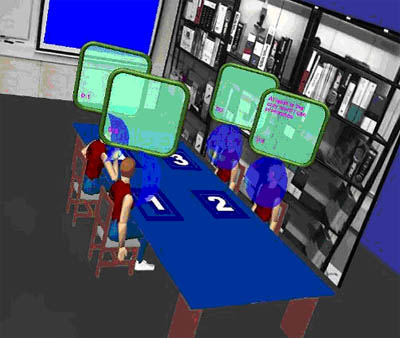
Figure 3. In the AMI-assisted Virtual Meeting Room, the focus of attention of the meeting participants is detected and helps an agent to behave according to meeting norms. Source: AMI Project
Detecting patterns could also help decisions in rendering agent actions (body language). If during a meeting everyone has their arms folded, would the remote participant also seek to assume this posture as well? These are other examples of how using AMI technology to detect patterns will be potentially valuable during meetings.
Support during meetings
In much the same manner as archives can be resources to people between meetings, or that AMI can help the late meeting participant get “caught up,” the recordings of past meetings should also serve as resources to participants during a meeting. Suppose participants in a meeting wish to answer a question about a previous meeting. Features similar to those accessible between meetings should be available but would also take into account the participants of the live meeting and the sensitivity of the sources or contents of past meetings. […]
Meeting Agents
Frequently it is necessary for the success of multiple projects for a person to be assigned responsibilities with overlapping time requirements. Another scenario for AMI technologies includes a system which helps knowledge workers “attend” two or more meetings simultaneously. The individual may participate in one meeting in person or by telephone and request to have an agent monitor one or more meetings. Provided participants in another meeting agree, the monitoring agent can be configured to detect real time events such as changes in the agenda, discussion of a particular item on the agenda which concerns the employee directly, a new person entering the meeting or someone who is known to be important leaving a meeting. This could optimize the use of limited human resources.
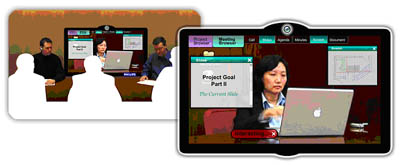
| Figure 4. The AMI technology-based remote meeting assistant can help those who cannot attend a meeting to send their agents to monitor a meeting in progress. Source: AMI ProjectIn the AMI demonstration of this scenario, the Remote Meeting Assistant (RMA) will detect events (e.g., keywords, entry or exit, change in dialog, debates) which it has been configured to monitor and alert the user. These could be real time alerts (via a pop up or toaster like an Instant Message) and they could be compiled for later review. Taking action based on information provided by a RMA would require first gaining the context for the alert, perhaps by way of an accelerated playback of recent remarks or discussion. […] |
To read the full article: click here Christine Perey is a speaker at our Season Event about the future of Business Meetings on October 5th. |
Club of Amsterdam blog
 | Club of Amsterdam blog October 26: Synthesis of elBulli cuisine October 14: The new Corinthians: How the Web is socialising journalism September 20: A Future Love Story |
News about Business Meetings

Honda Motor and the Advanced Telecommunications Research Institute International (ATR) have jointly developed new technology that enables a robot to mimic the movements of a person by reading the patterns of activity in the person’s brain. Clench your fist, and the robot does the same; hold two fingers up, and the robot does likewise. Researchers in the West have already developed technology in which devices can be operated by implanting electrodes in the brain or controlling blood flow through special exercises, but this is the first system in the world to achieve robotic movement using changes in the natural blood flow caused by brain activity.

eyescreen
“Based on breakthrough, super-fast P-OLED technology, eyescreens offer spectacular blur-free video using almost zero power to deliver continuous video entertainment to a new generation of wirelessly connected, lightweight, low cost and stylish video glasses.”
News about the Future

At London’s Heathrow Airport, starting in summer of 2008, 19-computer steered electric cars will go into operation. The automated taxis will be used to connect Heathrow’s Terminal 5 with a parking lot. The technology, which has been named “ULTra,” has been developed by the British firm ATS and is already being tested. The driverless vehicles pick up passengers after they are ordered and deliver them to their destination. Magnets or sensors on the ground direct the vehicles along their route.

bCODE-Drinks
A pervasive web application debuts In pubs and clubs in Sydney. Users of this web portal are able to buy “wireless drinks” for friends and colleagues — which are sent as encoded SMS messages — as well as being able to create and customise multimedia messages appearing on the video screens at bar venues upon scanning and redemption.
Next Event
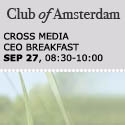 | Cross Media CEO Breakfast September 27, 2006, 08:30 – 10:00 Location: Westergasfabriek, Oostelijke Meterhuis, Haarlemmerweg 8-10, 1014 BE Amsterdam Entertainment, content, advertising, video, wireless, media rights, news, movies, TV, games, blogging, SMS … Meet the Experts: Gabriele Gresta, Deputy Chairman, Digital Magics Group (Italy) Madanmohan Rao, Consultant and prolific writer from Bangalore, Research Director, Asian Media Information and Communication centre (AMIC), Singapore Sylvia Paull, Founder, Berkeley Cybersalon (United States) Mary Hodder, CEO, Dabble (United States) Igor van Gemert, Founder & CEO, Innergy Creations BV Jonathan Marks, Director, Critical Distance BV Arnold Smeulders, Intelligent Systems Lab Amsterdam (ISLA) Simon Jones, Director, Human-Computer Studies Laboratory, University of Amsterdam Moderated by Bob Stumpel, Result Strategy, Cellsp ace, OpenBC, Ideabroker, LBI, GetMobile, TCS, Mendix, FON For decision makers in industry, government, science and education. There are only a few seats left! |
Innovation and Risk: The New Media Perspective
 | Simon Jones Director, HCS, University of Amsterdam former Managing Director, M.I.T. Media Lab Europe |
INTRODUCTION
Most people are in favour of innovation. Fewer are in favour of risk, unless it is with someone else’s money or time. New Media is an area where innovation is particularly fruitful and fortunes and reputations can be won and lost in a matter of months. New Media is therefore a useful area to study when seeking to understand the rules and rituals associated with successful innovation in high-tech and the management of its associated risks.
This paper gives an overview of my own perspective in New Media innovation arising out of my time leading the MIT Media Lab’s European operations and from founding Ictinos Innovation Ltd, a company that assists regions and SME’s and corporations in making innovation work.
WHY INNOVATE?
So why should we innovate? After all if something is not broken why try to fix it? Shouldn’t we maximise our return on the investment? Shouldn’t we ‘sweat the assets’ or ‘stick to the knitting’ or a hundred similar phrases heard routinely in meeting places all across the developed world?
Well it is reasonably well agreed that an approach based on innovation offers the best opportunity for maximising the use of resources both old and new. Furthermore, in the high-tech and consumer world where product life-spans are short and consumer interest is increasingly fickle, an approach based on innovation may be the only effective strategy for long term prosperity.
Globalisation adds its voice to the need to constantly innovate. China is rapidly becoming the world’s factory and India its’ services centre. For Europeans, like me, who have become accustomed to an agreeably affluent and secure lifestyle, working for low wages under difficult conditions is an unattractive and politically infeasible approach to countering this challenge. Specifically in New Media, if we are to avoid a future of US content playing on Chinese technology we will need to be more innovative than our competitors. And remember, the Chinese and Indians are not going to be content with the poor-paying jobs; they too are trying to climb up the innovation ladder as quickly as they can.
Perhaps our best hope for a prosperous future is to rely on the culturally rich, design-centric and highly-educated characteristics of European society and ally it to processes and infrastructures that permit continual change, flux and interaction between technologies, networks, consumers and content. This is a major economic and political challenge indeed.
Already the ‘creative’ sector (to use an already inexact term rather loosely) accounts for 10% of the EU economy. As factories ship out to China and software centres relocate to India, the creative sector is likely to assume an ever-growing importance to our financial well-being.
While in the high-tech internet-enabled consumer sector there are agreeably low barriers to entry and markets are world wide, this applies to the competition as well. In this sector there is always a start-up waiting to invent a new market (www.youtube.com for video sharing, for example) or steal an existing one away from established competitors (www.skype.com, taking away significant voice traffic from the Telco’s). So whatever current innovation you have, you better have a subsequent one as well before the first one gets taken away or bettered.
NEW MEDIA
We live in a world where generating new forms of content, for entertainment, business or a social aspect is increasingly important. The generic term for this is New Media. It’s more than TV or Radio Programs. It’s more than Web pages and SMS. It is fundamentally about interaction and a move away from the old, single sender, multiple receiver models of TV/Radio and a move towards a world where most people contribute as well as receive content and where multi-person real-time interaction is omnipresent. Already significant activity exists in this area, with blogs (57% of US teenagers have uploaded material to the web) gaming (5M subscribers to World of Warcraft), video sharing, interactive services, a plethora of ‘adult’ applications (curiously, the porn industry has been responsible for many more application advances than the music industry), interactive massively-multi player games. These are all delivered using the Internet Protocol for transmission, a mixture of cable/glass fixed networks and UMTS (3G) mobile networks. In conjunction with the diversity of delivery mechanisms, this material can be received on TV screens, PC’s, laptops, PDA’s and mobile phones. The hackneyed words of ubiquity, personalisation and asynchronicity all describe well an emerging world in which where and when you are on-line is not an obstacle to accessing the world of New Media content.
[…]
Read the full article in the Summit for the Future Report 2006!
You can listen to his presentation and download it as an mp3 file in our Jukebox
Simon Jones is a speaker at the Cross Media CEO Breakfast, September 27
Recommended Book
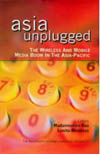
Asia Unplugged: The Wireless and Mobile Media Boom in the Asia-Pacific (Asia-Pacific Internet Handbook)
by Madanmohan Rao, Lunita Mendoza
This detailed and analytical handbook is a major source of reference for those with an interest in the wireless explosion in the Asia-Pacific region.
It includes thematic papers on WiFi//WLL, wireless content, portals, m-commerce, permission marketing, LBS, wireless development centres, enterprise wireless strategies, capacity-building, corporate policy, legal issues, hybrid models, regulation, and venture capital. The volume also includes detailed country profiles.
Madanmohan Rao is a speaker at the Cross Media CEO Breakfast, September 27
October 5: the future of Business Meetings
the future of Business Meetings
Thursday, October 5, 2006
Registration: 18:30-19:00, Conference: 19:00-21:15
Where: Syntens, De Ruyterkade 5, 1013 AA Amsterdam [Building of the Chamber of Commerce]
In the future, there will be many new processes and technologies to help participants and organizers prepare and manage meetings for superior communications and outcomes.
Christine Perey, AMI technology transfer specialist:Introduction
Des Leach, Research Fellow, Institute of Work Psychology, University of Sheffield: Meetings and their Participants – the Balancing Act between Business and Personal Factors
Pierre Wellner, Senior Scientist, IDIAP Research Institute, Martigny, Switzerland: The Whole Meeting in Half the Time
Wilfried Post, Researcher, TNO Human Factors: Join Multiple Simultaneous Meetings Without Neglecting Your Personal Priorities
moderated by John Grüter, Digital Knowledge
The Tarot Garden by Niki de Saint Phalle
The Tarot Garden by Niki de Saint Phalle
Influenced by Gaudí´s Parc Güell in Barcelona, and the garden in Bomarzo, de Saint Phalle decided that she wanted to make something similar; a monumental sculpture park created by a woman. In 1979, she acquired some land in Garavicchio, Tuscany, about 100 km north-west of Rome along the coast. The garden, called Giardino dei Tarocchi in Italian, contains sculptures of the symbols found on Tarot cards. The garden took many years, and a considerable sum of money, to complete. It opened in 1998, after more than 20 years of work.
Agenda

| Cross Media CEO Breakfast September 27, 2006, 08:30 – 10:00 Location: Westergasfabriek, Oostelijke Meterhuis, Haarlemmerweg 8-10, 1014 BE Amsterdam Entertainment, content, advertising, video, wireless, media rights, news, movies, TV, games, blogging, SMS … Meet the Experts! |
| The future of Business Meetings October 5, 2006, 18:30 – 21:15 the future of Food Design November 23, 2006, 18:30 – 21:15 the future of Consciousness January 25, 2007, 18:30 – 21:15 the future of Ambient Intelligence February 22, 2007, 18:30 – 21:15 the future of Global Workplace March 29, 2007, 18:30 – 21:15 the future of Success April 26, 2007, 18:30 – 21:15 the future of Tourism May 31, 2007, 18:30 – 21:15 Taste of Diversity June 28, 2007, 18:30 – 21:15 |
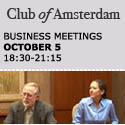 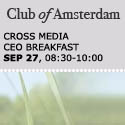 |
Club of Amsterdam Open Business Club
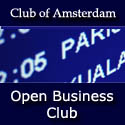 | Club of Amsterdam Open Business Club Are you interested in networking, sharing visions, ideas about your future, the future of your industry, society, discussing issues, which are relevant for yourself as well as for the ‘global’ community? The future starts now – join our online platform … |


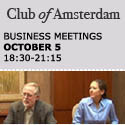








Customer Reviews
Thanks for submitting your comment!